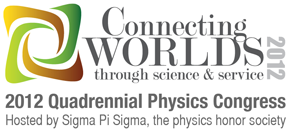Once every four years Sigma Pi Sigma, the physics honor society, hosts a unique meeting that brings together undergraduate and graduate physics students, practicing physicists, and physics alumni for a weekend of cutting edge science and reflection on the role of the scientist in society. The Quadrennial Physics Congress (PhysCon) is unlike any other physics meeting, combining round-table discussions, distinguished speakers, and laboratory tours with poster sessions and celebrations of art and science.
The 2016 Quadrennial Physics Congress (PhysCon), will be held November 3-5, 2016, in the Silicon Valley & San Fransisco, CA, area, near the home of the Stanford Linear Accelerator Center (SLAC). Be part of the action in 2016 – make plans now to attend PhysCon!
Learn more about the history of the Physics Congress in the Sigma Pi Sigma website.
The 2008 Congress was an energetic, inspiring meeting of more than 600 physics students, faculty, and alumni at Fermi National Accelerator Laboratory in Batavia, IL. The 2012 PhysCon built on the energy and enthusiasm of the 2008 Congress with over 800 participants exploring the theme Connecting Worlds Through Science and Service in Orlando, FL, near the home of the Kennedy Space Center.
Connecting Worlds Through Science & Service From global warming to Facebook to the International Space Station, we’re realizing now, more than ever, how connected we all are — as physicists, as scientists, as members of society, as humans, and as part of a vast universe.
The idea of scientists, and especially physicists, usually conjures up visions of solitary individuals set apart from society, using obscure tests to determine universal laws. But this period, if it ever really existed, has long passed. While we are still trying to determine universal laws, there is no way we are isolated – from other scientists or from the world at large.
International and interdisciplinary collaboration has become the norm. The first detector performance results posted by the CMS group at CERN had more pages devoted to its author list than to science content. Interdisciplinary fields such as medical imaging and nanotechnology are now at the forefront of science and society. Physicists collaborate with biologists, economists, and engineers to help with issues such as education, green energy, and clean water.
We’re applying our skills and understanding to questions traditionally outside of our field. We are not only sharing the results of our research, but working with policy makers and community leaders to influence how those results are used. We are forging new connections to make the most of our fast-paced, information-driven society.
What do all of these connections mean? How can we make the most of them? What challenges should we prepare for, and how? How are the expectations and responsibilities of scientists changing?
The setting for the 2012 Quadrennial Physics Congress is an area characterized by such connections: Orlando, FL, home to NASA’s Kennedy Space Center. Building on the 2008 theme of scientific citizenship, the 2012 Congress addresses the necessity, practicality and ideals of making connections, whether they are between student and professor, scientist and society, or Earth and exoplanet.






